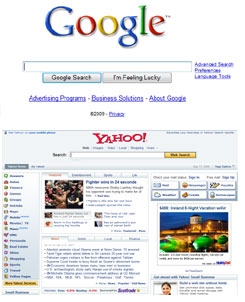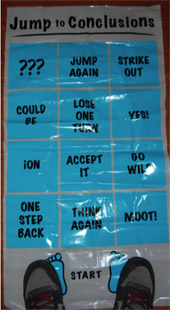Web Strategy: You Can’t Bloat Your Way to the “Killer App”
 There is a battle between 2 basic strategies that plays out on the web time and time again with consistent and predictable results.
There is a battle between 2 basic strategies that plays out on the web time and time again with consistent and predictable results.
On one side there’s “Keep it Simple Stupid” (KISS), best exemplified by Google; and on the other side it’s “Build Lots (and lots, and lots, and lots) of Application-fattening Tools” (BLOAT), best executed by Yahoo.
KISS is about relevance and resonance.
When executing the KISS strategy, it’s all about finding and solving the “main thing” - i.e., what is the user’s single biggest hot button (maximum relevance), and how do we overdeliver on that with excitement (maximum resonance).
For Google’s audience, it was all about relevant search results, and so Google focused on search and only search. For MP3 players, the goal of most users was to play MP3’s (go figure!) - and so Apple focused on delivering the simplest way to do just that. For Sales Force Automation, it was about easy pipeline management; and so SalesForce.com delivered it.
All 3 of these players grabbed enormous market shares in seemingly “crowded markets” by finding “the thing”, and delivering on that and only that.
The BLOAT Strategy - it slices and it dices; it delivers everything but a solution to the “main thing”.
BLOAT actually starts in the same place as KISS - with the seed of an idea that tries to get to the heart of the “main thing”. The problem is - then it keeps going, and going, and going to lots and lots of lower priority features. The underlying concept is, if we’re not super-confident that the end user is going to be wow’ed by the “main thing”, then we better gold-plate it with lots of razzle dazzle so that they’ll still end up liking the product.
But the problem is - if we don’t nail the end user’s “main thing”, then all the razzle-dazzle and functionality in the world isn’t going to change the fact that we failed to engage them. At worst they’ll scoff, or yawn, at best they’ll claim to like it and then disappear into the ether never to be seen again. The combination of our attempt at the “main thing”, and all the added bells and whistles just didn’t stir any emotions, and so it was all wasted.
And it probably didn’t come cheap!
The only thing worse than failing to engage the end user with our new product or website is that we wasted an enormous amount of time, energy, and expense on “bells and whistles”. Instead of delivering a first iteration of the “main thing” in a matter of days or weeks (like we could have in the KISS scenario), we burned months of time, thousands or tens of thousands (or more) in expenses, and lots and lots of “buzzkill” - and we’re no further along than we could have been.
But what if we miss the “main thing” in the KISS Scenario?
If you miss the “main thing” under the KISS scenario, then either 1) you have the wrong audience, 2) you have the wrong hot button, 3) you didn’t quite hit “resonance”, 4) you are way way off.
Assuming any of the above (except #4), the good news is that you haven’t wasted a lot of time and iteration on your first attempt, so you probably have lots more “steam” available to iterate on a second, third, etc. attempt than if you had gone down the BLOAT path. When it comes together, it’s like a radio station that’s off by a hair - it doesn’t sound so good, but with a few tweaks it comes in crystal clear.
And so the moral of the story is…
Use the KISS strategy, get something (i.e., a Beta release) in front of real live users ASAP, and then iterate as rapidly as you can until you get it right. And avoid the BLOAT monster at all cost!
 We’ve all heard that we need to get our “ducks in a row” if we want to succeed as entrepreneurs. This is certainly true, but…
We’ve all heard that we need to get our “ducks in a row” if we want to succeed as entrepreneurs. This is certainly true, but… One of the funniest scenes in the 1999 movie classic “Office Space” happens when Tom Smykowski lets Peter, Samir and Michael in on his great idea for the “Jump to Conclusions Mat” - which is a “mat, with a whole bunch of conclusions on it, … that you jump to!”
One of the funniest scenes in the 1999 movie classic “Office Space” happens when Tom Smykowski lets Peter, Samir and Michael in on his great idea for the “Jump to Conclusions Mat” - which is a “mat, with a whole bunch of conclusions on it, … that you jump to!”